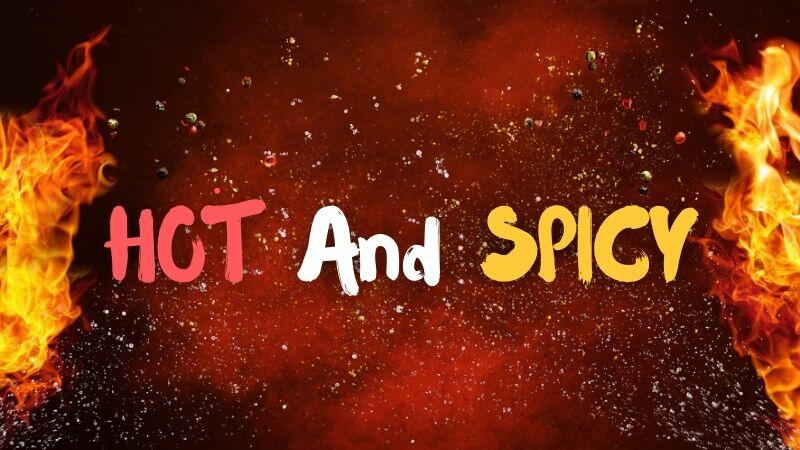Ever taken a big bite of food expecting a touch of
The terms “hot” and “spicy” are often used interchangeably in casual conversation. But culinary experts actually define them quite differently.
So what exactly is the difference between describing food as spicy versus hot?
While the two words are related, they refer to different tongue-scorching sensations:
- Hot refers to the burning feeling caused by chemical compounds like capsaicin found in peppers. This sensation can range from a mild tingle to an explosive inferno, as measured by the Scoville scale.
- Spicy indicates food seasoned with spices like black pepper, cumin, cinnamon, etc. Spices add flavored heat, but not necessarily searing intensity.
In short:
- Hot = chemical heat
- Spicy = flavorful heat
But in reality, it’s not always so black and white. Food can be both blisteringly hot AND abundantly spicy at the same time.
The lines between hot and spicy get blurred by:
- Regional cuisine preferences
- Individual heat tolerance
- Crossover ingredients that are hot AND spicy
- Confusing condiment names (hot sauce vs chili sauce)
This article will unravel the intricacies around describing food as hot and spicy. Discover the science behind pepper heat, the subtle flavors of various spices, and how to navigate menus filled with tongue-tingling dishes.
With the tools to articulate different degrees of searing, flaming zing, you can satisfy your craving for heat and flavor.
So get ready to turn up the dial on your taste buds’ tolerance for hot and spicy sensations!
The Blurred Lines Between Hot and Spicy
In casual conversation, most people use “hot” and “spicy” interchangeably. Food can be described as “hot and spicy” without distinguishing between the terms.
Some argue “hot” should only reference temperature, not spiciness. But when your mouth feels like it’s on fire after eating a habanero pepper, “hot” seems quite fitting!
Meanwhile, “spicy” doesn’t have to mean eye-watering heat. A stick of cinnamon is spicy but won’t scorch your taste buds.
Context usually makes it clear which sensation is meant by “hot” or “spicy.” But the vocabulary gap causes misunderstandings, especially surrounding spicy food preferences.
Measuring Hot Pepper Heat with the Scoville Scale

How exactly do peppers deliver that addictive burning sensation? The secret lies in a chemical compound called capsaicin.
In 1912, scientist Wilbur Scoville devised a method to measure capsaicin heat in peppers. It became known as the Scoville scale.
Here’s a simplified explanation of how he did it:
- Take dried peppers and extract the capsaicin into a solution.
- Add sugary water to dilute the extracted capsaicin.
- Have tasters sample the solution until they no longer perceive heat.
- The number of dilutions needed determines the pepper’s Scoville Heat Units (SHU).
This testing method revolutionized understanding pepper heat.
Breaking Down the Scoville Scale
The Scoville scale ranges from 0 SHU for a bell pepper to over 15 million SHU for pure capsaicin. Here are a few comparisons:
- Jalapeño – 2,500 to 8,000 SHU
- Habanero – 100,000 to 350,000 SHU
- Carolina Reaper – 1,400,000 to 2,200,000 SHU
- Pepper spray – 2,000,000 to 5,300,000 SHU
Nowadays, chromatographs measure capsaicin content more precisely than human tasters. But the Scoville scale remains the standard for quantifying pepper heat.
How to Describe Spicy Food
With so many nuances between hot and spicy, how do you accurately describe food containing tongue-torching flavors? Here are some tips:
- Use comparative scales like mild, medium, or max to quantify
spice levels. What’s mildly spicy to one person could be scream-inducing to another! - Note the type of heat – Does it provide a slow burn or instant blast? Where do you feel it – front of mouth or throat?
- Describe the flavor beyond just heat. Does it have a citrusy zing, earthy kick, or smoky essence?
- Specify ingredients providing the
spice , like chili peppers, Sichuan peppercorns, or spicy chai masala. - Compare dishes to benchmark
spice levels like a jalapeño or vindaloo curry. - Use vivid imagery – searing, blast furnace, volcano – to convey the sensation’s intensity.
With creative descriptive language, you can articulate precise
Is Hot a Taste?
When describing spicy and hot foods, you may have wondered – is hot actually a taste?
Scientifically, hot is not one of the basic taste profiles detected by the human tongue. The pillars of taste are sweet, sour, bitter, salty, and umami.
Instead, the burning “heat” from peppers and other spicy ingredients is detected by nerve receptors that react to irritation and temperature change. So hot is more of a pain signal than a defined taste.
That said, the food world recognizes the sensation of heat as a key flavor profile. Taste is a complex experience involving smell, texture, and trigeminal nerve reactions too.
While hot may not fit neatly into the taste bud model, it has an undeniable impact on overall flavor. The rush of endorphins and heightened sensory experience from
Describing Spicy Food Beyond Heat
While the Scoville scale focuses on “hot hot,” the culinary world needs vocabulary to describe other
Chefs use terms like pungent, piquant, and warming to convey flavor nuances. Certain compounds deliver spiciness without significant heat, like:
- Piperine is the mild, short-lasting heat that comes from peppercorns. Chefs describe this flavor as “peppery.”
- Allicin is a part of the garlic family and has a pungent, mild heat. This flavor falls under the “pungent” umbrella.
- Gingerol is the chemical compound found in ginger. It has a “warming” heat that enhances other compounds.
- Cinnamaldehyde is a piquant compound found in cinnamon. It enhances other compounds.
- Menthol comes from the mint family. It’s described as a “cold heat.”
- Ethanol is the chemical compound found in alcohol. It “burns on the way down.”
- Alpha Hydroxy Sanshool is the compound found in Sichuan peppercorns. This pepper has a “tingly” or “numbing” effect and was completely illegal in the United States until 2005, and even now, it’s still heavily regulated.
In short, spicy doesn’t have to mean blisteringly hot. An expert palette distinguishes between subtle spicy elements.
Differentiating Hot Sauce vs Chili Sauce
The naming of condiments causes further “hot” vs “spicy” confusion. But there are distinct differences between hot sauce and chili sauce:
Hot sauce contains peppers as the main ingredient. It aims to add scorching heat and typically has a watery vinegar base. Examples include:
- Tabasco
- Sriracha
- Cholula
Chili sauce uses chili peppers and often includes a tomato base. It has a thicker, ketchup-like texture and balances richer flavor with moderate heat. For example:
- Sriracha
- Sweet chili sauce
So in summary, hot sauce brings the heat, while chili sauce focuses on chili flavor.
Tips for Navigating Hot and Spicy Menus
With an understanding of the nuances between hot and spicy, you can now make informed choices when ordering food:
- Ask for clarification on what makes a dish “hot” or “spicy” if it’s unclear from the menu description.
- Know the Scoville scale for common peppers so you can gauge potential heat levels.
- Start mild and add more heat to suit your preferences. It’s easier to make a dish spicier than to tame it down.
- Check the ingredients to determine if a sauce or seasoning will deliver true heat or more complexity.
Armed with the right lexicon, you can confidently order dishes with your ideal level of tantalizing zing and fire.
Satisfying Your Hunger for Heat and Flavor
Hopefully this guide has helped unravel the complex linguistic differences between “hot” and “spicy” when describing food. While they may be used interchangeably in casual chat, the culinary world recognizes distinct meanings.
Understanding the chemical compounds behind searing pepper heat and warm, fragrant spices allows you to articulate flavor experiences. So go forth and set your taste buds ablaze with the wide spectrum of hot and spicy sensations!
Sources
- UsingEnglish.com: Spicy and/or hot? What’s the difference?
- HiNative: What is the Difference Between Hot and Spicy?
- Reddit: Spices vs spicy vs hot
- YouTube: What is the difference between Spicy and Hot?
- Alimentarium: The Scoville Scale
- Chili Pepper Madness: The Scoville Scale
- The Nibble: Pungent vs Piquant foods
- PepperScale: What’s a Good Chili Sauce Substitute?
- Reddit: Do Chefs Have Different Words to Describe “Hot hot,” “Spicy hot,” and “Burning Hot?”





